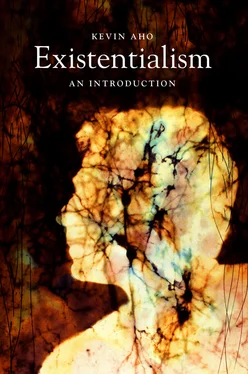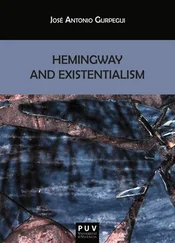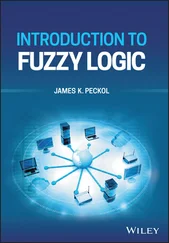Kevin Aho - Existentialism - An Introduction
Здесь есть возможность читать онлайн «Kevin Aho - Existentialism - An Introduction» весь текст электронной книги совершенно бесплатно (целиком полную версию без сокращений). В некоторых случаях можно слушать аудио, скачать через торрент в формате fb2 и присутствует краткое содержание. Год выпуска: 2013, ISBN: 2013, Издательство: Polity, Жанр: Философия, на английском языке. Описание произведения, (предисловие) а так же отзывы посетителей доступны на портале библиотеки ЛибКат.
- Название:Existentialism: An Introduction
- Автор:
- Издательство:Polity
- Жанр:
- Год:2013
- ISBN:978-0745651422
- Рейтинг книги:3 / 5. Голосов: 1
-
Избранное:Добавить в избранное
- Отзывы:
-
Ваша оценка:
- 60
- 1
- 2
- 3
- 4
- 5
Existentialism: An Introduction: краткое содержание, описание и аннотация
Предлагаем к чтению аннотацию, описание, краткое содержание или предисловие (зависит от того, что написал сам автор книги «Existentialism: An Introduction»). Если вы не нашли необходимую информацию о книге — напишите в комментариях, мы постараемся отыскать её.
Existentialism: An Introduction
Existentialism: An Introduction — читать онлайн бесплатно полную книгу (весь текст) целиком
Ниже представлен текст книги, разбитый по страницам. Система сохранения места последней прочитанной страницы, позволяет с удобством читать онлайн бесплатно книгу «Existentialism: An Introduction», без необходимости каждый раз заново искать на чём Вы остановились. Поставьте закладку, и сможете в любой момент перейти на страницу, на которой закончили чтение.
Интервал:
Закладка:
The impersonal and dehumanizing characteristics of the bureaucratic state were magnified by the Industrial Revolution with its wrenching pace, numbing repetitiveness, and alienating working conditions that became commonplace in the massive factories of Western Europe and the United States. A number of existentialists engaged the problem of alienation rising from the standardization and collectivization of the human being in the machine age. In his Notes from the Underground (1864), for instance, Fyodor Dostoevsky (1821–1881) mockingly described this form of mechanized social engineering in terms of a ‘Crystal Palace,’ a reference to the huge glass and cast-iron building that housed the Great Exhibition in London and displayed the latest scientific and technological breakthroughs of the industrial age. For Dostoevsky, the Crystal Palace was not a sign of rational progress but a nightmare, symbolizing lifeless conformism, loneliness, excessive pride, and the mutilation of human existence. After personally vising the building in London in 1862, he wrote:
The Crystal Palace … you sense that here something has been achieved, that here there is victory and triumph. You even begin to fear something. However independent you may be, for some reason you become terrified. ‘For isn't this the achievement of perfection?’ you think. ‘Isn't this the ultimate?’ … People come with a single thought, quietly, relentlessly, mutely thronging into this colossal palace, and you feel that something has come to an end. It is like a Biblical picture, something out of Babylon, a prophecy from the Apocalypse coming to pass before your eyes. … In the presence of such hugeness, of the colossal pride of the sovereign spirit, of the triumphant finality of the creations of that spirit, even the hungry soul takes flight; it bows down, it submits, it seeks salvation in gin and debauchery and believes that everything is as it ought to be. The fact lies heavy; the masses become insensible and zombie-like. (2009, 92)
Given these wrenching social upheavals that characterized the modern age, it is no surprise that by the turn of the century, literary and philosophical references to inchoate feelings of anxiety, boredom, and suicide were becoming increasingly common. Indeed, in 1881, the American physician George M. Beard introduced the term ‘neurasthenia’ to the medical lexicon, referring to feelings of profound nervous exhaustion and anxiety that were becoming an epidemic in the industrialized cities of Germany, England, and the United States. According to Beard, “The chief and primary cause of this development and the very rapid increase of nervousness is modern civilization [itself]’ (1881, vi). With these conditions in place, the seeds of existentialism were sown.
No philosopher was more tuned into the upheavals of modernity than Friedrich Nietzsche (1844–1900). His words vividly convey the frightening sense of abandonment and forlornness in the modern age, where moral absolutes can no longer serve as a source of security and meaning for our lives. This experience is powerfully captured in The Gay Science with his famous account of the ‘madman’ who descends into the marketplace to announce to the world that ‘God is dead!’:
‘Where has God gone?’ [the madman] cried, ‘I'll tell you where! We've killed him — you and I! We are all his murderers! … Aren't we wandering as if through an endless nothing? Isn't empty space breathing upon us? Hasn't it gotten colder? Isn't night and more night continuously coming upon us? Don't lanterns have to be lit in the morning? Don't we yet hear the noise of the gravediggers who are burying God? Don't we yet smell the divine rot? — For gods rot too! God is dead! God remains dead! And we have killed him!’ (1995, 125)
For Nietzsche, the traditional idols of Greek reason and Judeo-Christian faith have been destroyed by the new science, exposing them as fleeting human constructs, ‘metaphysical comforts’ that have been employed for millennia to conceal our underlying frailty. But Nietzsche makes it clear that the new science is just one more idol that we construct and cling to for security. Regardless of its success at rationally ordering and subduing the natural world, the answer to the question of what it means to be human cannot be provided by means of any scientific proof. “We have arranged a world for ourselves in which we can live,” says Nietzsche, “by postulating bodies, lines, planes, causes and effects, motion and rest, form and content; without these articles of faith, nobody could stand to live now! But this still does not mean that they have been proved. Life is no argument ” (121, my emphasis).
Existentialism as a cultural mood
Nietzsche's announcement of God's death set the stage for much darker events in the first half of the twentieth century that appeared to confirm his prophecy: the horrors of the Great War and World War II, the Nazi death camps, and the atomic bombings of Hiroshima and Nagasaki. After 1950, there was the threat of global annihilation during the Cold War, regional explosions of racial and colonial violence, and increasing environmental devastation. All this contributed to a cultural mood in Europe and America: a feeling that life was fundamentally absurd; that we are estranged from each other and not at home in the world; and that because there are no moral absolutes, we are left alone, rudderless and adrift in a “terrifying infinity,” with nothing and no one to tell us how to live our lives (Nietzsche 1995, 124). Although Nietzsche offered the clearest and most powerful articulation of this predicament and laid the intellectual groundwork for understanding the modern experience of nihilism, there were other important fin de siècle literary figures that played a crucial role in giving voice to the anguished confrontation with modernity. Although offering an exhaustive account of these figures is beyond the scope of this book, a number of key works are worth mentioning in order to get a sense of the chronology and the cultural and geographical scope of the movement.
As we will see in proceeding chapters, a number of Russian writers were uniquely equipped to address the upheavals of modernization because the process happened so quickly in Russia. In the span of a few decades in the middle of the nineteenth century, Russia rapidly transitioned from a feudal economy that was historically rooted in the close-knit indigenous practices of the Eastern Church to one that embraced the ideals of the Enlightenment and the secular values of egoism and scientific materialism that constituted this new worldview. Literary works that critically engaged these wrenching social transformations include Ivan Turgenev's (1818–1883) Fathers and Sons (1862), Dostoevsky's Notes from the Underground, Crime and Punishment (1860), and The Brothers Karamazov (1880), and Leo Tolstoy's (1828–1910) The Death of Ivan Ilych (1886). The Russian essayist Lev Shertov (1866–1938) also played an important role by introducing and synthesizing the works of Nietzsche, Tolstoy, and Dostoevsky with two important books, Good in the Teaching of Tolstoy and Nietzsche (1900) and Dostoevsky and Nietzsche: The Philosophy of Tragedy (1903). There were also important works published by Norwegian contemporaries, like Henrik Ibsen's (1828–1906) A Doll's House (1879) and Knud Hamsun's (1859–1952) Hunger (1890), that addressed similar themes of social fragmentation and alienation. By the first decade of the twentieth century, existentialism's confrontation with modernity was beginning to gain broader appeal. In addition to the writings of Kafka, whom we previously mentioned, the great German-language poet Rainer Maria Rilke (1876–1926) published his hugely influential novel The Notebooks of Malte Laurids Brigge (1910) that engaged issues of human finitude and meaninglessness. In 1913, the Spanish poet and philosopher Miguel de Unamuno published his masterwork The Tragic Sense of Life , addressing the concrete concerns of “the man who is born, suffers, and dies” (1954, 1). And, in 1914, the Spanish philosopher José Ortega y Gasset (1883–1955) would publish Mediations on Quixote that developed the idea of the human being as free and self-creating. Meanwhile, in Germany, the philosopher Martin Heidegger (1889–1976) reflected the Zeitgeist with a series of legendary lecture courses at Freiburg University in the early 1920s where he developed Wilhelm Dilthey's (1883–1911) notion of historical ‘thrownness’ and Kierkegaard's ideas of anxiety, freedom, and death, culminating in the first systemic analysis of human existence, his magnum opus Being and Time (1927). And Heidegger's contemporary in Germany, Karl Jaspers, would establish an analogous ‘philosophy of existence’ (or Existenzphilosophie ) that focused on the importance of ‘limit situations’ like anxiety in the face of death that have the power to awaken us to the frailty and impermanence of our lives.
Читать дальшеИнтервал:
Закладка:
Похожие книги на «Existentialism: An Introduction»
Представляем Вашему вниманию похожие книги на «Existentialism: An Introduction» списком для выбора. Мы отобрали схожую по названию и смыслу литературу в надежде предоставить читателям больше вариантов отыскать новые, интересные, ещё непрочитанные произведения.
Обсуждение, отзывы о книге «Existentialism: An Introduction» и просто собственные мнения читателей. Оставьте ваши комментарии, напишите, что Вы думаете о произведении, его смысле или главных героях. Укажите что конкретно понравилось, а что нет, и почему Вы так считаете.












